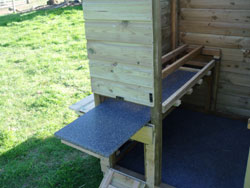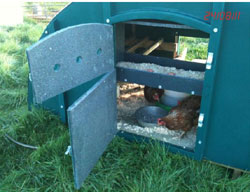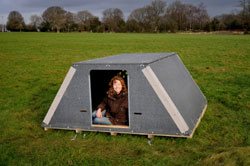



Using Sustainable Materials and Alternative Energy Forms
Farmers instinctively want to do the right thing sustainably. After all, farmers maintain, protect and enhance a large part of the UK’s landscape by the very nature of what they do. Small-holders and large scale producers alike carry a unique responsibility to manage the countryside, writes Louise Barnett for EcoSheet in the UK.



Understanding and managing our environmental footprint is a key priority at the same time as producing the food we need to eat individually and as a nation. The Government’s chief scientist Professor John Beddington has called it ‘the perfect storm’ – the challenge of producing 50 per cent more food by 2030 while adapting to climate change.
If anyone knows about climate change, farmers do. After all, it is they who notice the effect it is having on harvesting and feeding. They get to experience it first-hand.
Given all the challenges that farmers are facing at a time when the bottom line seems to be all that matters, how easy is it being green? And is it as simple as just having the right sustainable farming practices and production methods?
Well not exactly. It is true that that these lie at the heart of sustainability, however, we also need to consider other aspects of what we do, from the top to the bottom of the chain. For example, what about the buildings in which we house our animals? How many of us can say that we use sustainable materials and alternative forms of energy in our animal housing to make them truly sustainable?
Of the two, renewable energy is certainly higher up the awareness scale for farmers than sustainable building materials. Recent research by the NFU and NatWest is evidence of this as it revealed that 30 per cent of farmers across England and Wales will be involved in some form of renewable energy production, use or supply by the end of the summer.
Around one in five will be producing clean electricity, one in six will have installed solar PV and a further one in eight will be using or generating renewable energy. The findings suggest agriculture will make a significant contribution to the UK target of producing 15 per cent of our energy from renewable sources by 2020, as set by the EU Renewable Energy Directive.
One high profile farmer who has already seized the renewable energy opportunity and is looking into other sustainable construction options is TV presenter Kate Humble who has established a brand new centre for rural skills and animal husbandry in Monmouthshire.
According to Kate, she has spent hours scouring the internet trying to work out what system or combination of systems would work best at the farm – ground source or air source? Biomass or PV? Sheep’s wool or fibreglass? She’s also explored effectively storing rainwater and using it for the water troughs, doing clever things with cow poo and even thinking about having a wind turbine installed on her land – although she thought twice about this and opted instead for biomass, a boiler system powered by wood for which you can get grants to help fund it.
So what about the building materials that farmers typically use for housing their animals, food and equipment? Exactly how sustainable are they and what can we do to make them better? There are certainly some lessons to be learnt from the construction industry, which over the past few years has made great gains when it comes to encouraging sustainable construction, minimising waste and maximising recycling.
This included a voluntary agreement by many of the country’s major construction companies with WRAP, the government-backed Waste & Resources Action Programme, to halve construction waste to landfill by 2012. Likewise, the development of new technologies, including 100 per cent recyclable materials, has been another positive move and something the farming industry now needs to take on board.
As farmers, we are a pretty self-sufficient lot and tend to use whatever materials we can to construct the buildings, fences and shelters we need to do the job efficiently. But that has often meant using materials that aren’t from a sustainable source and cannot be recycled at the end of use which means they usually end up in landfill.
Plywood for example is used extensively in farming for a whole manner of construction needs; from animal housing and feeding troughs to storage, partitions and fencing. Yet whilst plywood is extremely versatile, it does have its limitations due to the very nature of the conditions it has to withstand.
Explains one poultry farmer: “The problem with mixing plywood and poultry is that, inevitably, the plywood will erode fairly quickly due to the effects of mud, rain water, excrement and rotting food waste. Plus plywood does have a tendency to harbour pests such as red mite which is the scourge of the poultry farmer.
“I would generally expect a construction made from plywood that is exposed to these kinds of elements to last no more than three years before I have to replace it. I then have to deal with its disposal and replacement, which requires a certain amount of time, effort and money. It’s an ongoing process across the farm.”
From a sustainability viewpoint, plywood isn’t the ideal solution either as it cannot be recycled after use. Which means that 25 million sheets of the stuff are disposed of in landfill each year in the UK alone.
The good news is that thanks to new technologies, there are now several sustainable alternatives which don’t cost the earth, perform in a similar way to plywood yet offer a host of benefits that plywood does not including increased disease resistance, cleanliness and more.
One such product is EcoSheet which is made entirely from unwanted waste plastic sourced from farms, businesses and homes. Due to its sustainable qualities, durable nature and cost effectiveness, EcoSheet is increasingly being used in the farming industry for animal housing for a range of livestock including poultry and pigs.
EcoSheet has a number of advantages over plywood in practical terms, including the fact it doesn’t rot, doesn’t contain adhesives and preservatives and is easier to clean which improves animal welfare. It has a hard foam core helping to insulate birds and animals against temperature changes, is resistant to bird lime and animal urine and can be washed and treated easily against red mite.
EcoSheet has the added benefit that it can be recycled again and again, making it a good, sustainable solution for farmers both environmentally and economically, which is something that Kate Humble has already recognised as she has started using it for her animal housing needs on her Monmouthshire farm.
She says: “EcoSheet is a tough, durable and practical alternative to plywood and costs almost the same,” explains Kate Humble. “We've lined an animal shed with it - it is easy to clean and it is a great insulator. Its other great appeal to me is that it makes really good use of one of the most problematic items of waste we produce - plastic. Not only is it made entirely from recycled material, it can be completely recycled if it does become damaged or broken.”
Colin Bucknell from Devon, an animal housing manufacturer, is using EcoSheet in his chicken arcs: “Whereas plywood rots easily, EcoSheet doesn’t and it is easier to jet wash clean, making it more disease resistant. This is certainly true in the case of red mite, which has really been cut down as a result of using EcoSheet.”
Many animal housing specialists and major agricultural merchants including BATA, Carrs Billington, Mole Valley, Wynnstay and Bridgmans now stock EcoSheet, which is comparable in price to treated plywood. For further details, go to www.EcoSheet.com








